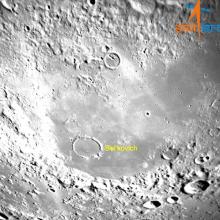Listen to today's episode of StarDate on the web the same day it airs in high-quality streaming audio without any extra ads or announcements. Choose a $8 one-month pass, or listen every day for a year for just $30.
You are here
Moon and Spica
By Earthly standards, a hard vacuum surrounds the surface of the Moon. Yet it’s not a complete vacuum — the Moon has a thin atmosphere.
Much of the material that makes up the atmosphere comes from the surface. It’s kicked off of rocks and dirt by the solar wind or by impacts by tiny space rocks.
And some of the material may come from inside the Moon — mainly from dormant volcanoes.
Billions of years ago, volcanic activity might have given the Moon a much thicker atmosphere. Bombardment by giant space rocks punched holes in the crust. That allowed molten rock to spill onto the surface. The magma contained hydrogen, oxygen, and other gases. Researchers say that some of the gases — including water vapor — could have formed an atmosphere that was thicker than that of present-day Mars. And it could have lasted for up to 70 million years.
The Moon’s gravity just isn’t strong enough to hold on to that much “air,” though. The solar wind stripped most of it away, blowing it off into space.
But some of the water may have fallen back to the surface. And some of it may still be on the Moon today. It’s hidden in the bottoms of craters at the lunar poles, which are always in shadow — icy traces of a vanished atmosphere.
Look for the Moon climbing into good view by about 10 or 10:30 the next couple of nights. The bright star Spica will stand to the lower right of the Moon tonight, and to the upper right tomorrow night.





